
With Bhangras and Jakaras – our very own beloved Fauja Singh crossed the finish line to be the first 100 year old to complete a marathon – thus also setting a world record. Running in the Scotiabank Toronto Waterfront Marathon, he may have been last in the pack – but he finished first in the hearts of all. Many of us were following our Torontonian brothers and sisters live tweet as #faujasingh as it began trending in Toronto and through all of Canada.
Here he is crossing the finishing line!

Will the centenarian hang up his Adidas shoes now that he has set this record? HARDLY! Next up – for us Californians, we get the chance to meet him at the upcoming SikhLens Film Festival in Southern California from November 18-20, 2011. Then back to the world stage for Fauja Singh as he will be part of the torchbearer relay for the 2012 London Olympics. Keep on running Fauja! #faujafever
Each year, SikhNet hosts an online youth film festival – to cultivate interest from Sikh filmmakers from around the globe. The online film festival is an excellent way for individuals to dialogue about issues affecting us personally and as a community. One of the films, titled Khalsa Has No Gender, is made by a group of young teen-aged Sikh women living in England and the goal of the film is to address gender [in]equality within our community. The film was striking to me for several reasons. Firstly, that these young women chose to use the medium of film to discuss this very important issue and secondly, that the concept of gender discrimination and inequality is prevalent in the conscience of very young Sikhs – Sikhs who are perhaps even 3rd and 4th generational living in the disapora.
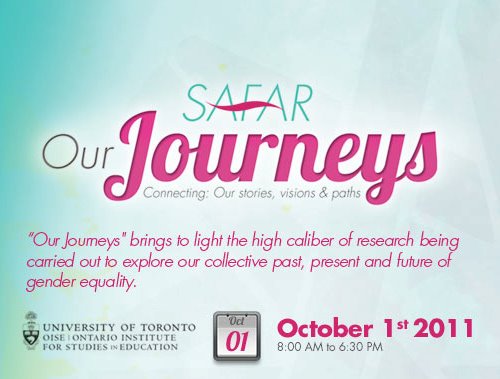 While on one hand it’s disheartening to acknowledge that perhaps change is slower than we have hoped it to be (displayed by the film), there is – on the other hand – reason to be optimistic. In just over a week, scholars and community members from across the globe are gathering in Toronto for the very first Sikh Feminist Conference, “Our Journeys”, hosted by the Sikh Feminist Research Institute (SAFAR).
While on one hand it’s disheartening to acknowledge that perhaps change is slower than we have hoped it to be (displayed by the film), there is – on the other hand – reason to be optimistic. In just over a week, scholars and community members from across the globe are gathering in Toronto for the very first Sikh Feminist Conference, “Our Journeys”, hosted by the Sikh Feminist Research Institute (SAFAR).
[Our Journeys is] an opportunity for scholars and community members alike to openly connect, converse and engage in a dialogue and critical thinking about gender related issues that demand to be voiced, and heard, in order to be addressed.
The line up of topics and speakers is remarkable. The keynote speaker, Professor Nikky-Guninder Kaur Singh is well known for introducing the term “Sikh feminism” and will share a Panel with Geetanjali Singh Chanda and Mallika Kaur to explore how Sikh feminism is defined, its origins, the present-day reality and how it can be an impetus for social change.
Guest blogged by Neesha Meminger
Admin note: In an effort to further cultivate the conversation on Faith and Feminism within the Sikh community, panelists from the Open Heart/Closed Fist event in NYC will share their thoughts with us. To learn more about the panel, please read Sikh Women Speak Out on Faith and Feminism.
::
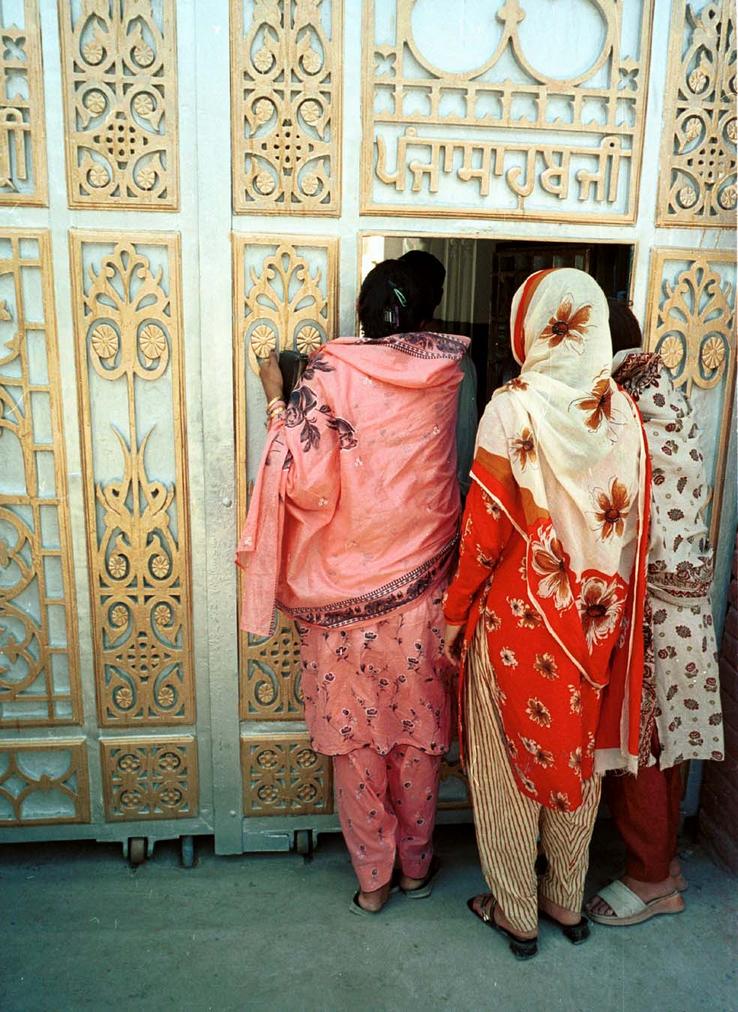 I walked away from our panel with mixed feelings. On the one hand – how exhilarating to sit in a room full of South Asian men and women and put a spotlight on the thoughts and experiences of Sikh women! I tried to remember when I ever sat in a room like that and spent two hours or more talking about what it means to be a Sikh woman and the importance of that in my life – never mind the validation by others I barely knew or had just met. The fact that this space was created at all was enough to leave me feeling full, and bursting with the need to create more such spaces and conversations.
I walked away from our panel with mixed feelings. On the one hand – how exhilarating to sit in a room full of South Asian men and women and put a spotlight on the thoughts and experiences of Sikh women! I tried to remember when I ever sat in a room like that and spent two hours or more talking about what it means to be a Sikh woman and the importance of that in my life – never mind the validation by others I barely knew or had just met. The fact that this space was created at all was enough to leave me feeling full, and bursting with the need to create more such spaces and conversations.
On the other hand, I realized, from some of the questions asked, that we are just at the beginnings of this dialogue. I have a lot of faith in our community, because I believe that out of all the other spaces in my life, this is where an honest conversation can take place; one that not only encompasses politics and radical discourse, but spirituality, as well. For if not here, where?
Sikhi was built, in part, on challenging the status quo. The founders of the faith were outraged at the injustices of their time and spoke up for the voiceless. They took to arms for the defenseless. The other, perhaps bigger, part was the right to own one’s own relationship with god – to not entrust a middle person to interpret the word of god and to seek enlightenment from within. “Sat Nam: Truth be thy name” is one of the first teachings that resonated deeply for me. It encourages us to seek out the truth because that is where we find god. The relationship to the Divine is a deeply personal for everyone, and Sikhi acknowledges that the Almighty is neither male nor female, without image, without form. This, along with the fact that caste was rejected, and social equality upheld as a goal, allowed a gateway for all to worship as one, while owning their own spirituality.
Conversations about hair are often emotional for Sikhs – and therefore they are conversations which we tend to avoid. For many Sikhs, it is a constant struggle to explain the historical significance of keeping our hair and/or wearing a turban while other Sikhs will argue that simply keeping your hair or wearing a turban by no means makes you a good Sikh. While that may be true, being able to have conversations about hair is an incredibly important and necessary dialogue for us to participate in. Many Sikhs in the diaspora have struggled to maintain their identity, while Sikhs in Panjab are struggling to be western. It’s such an interesting juxtaposition and anybody who has visited Panjab recently will see the dwindling number of Sikh boys choosing to wear turbans. In an effort to explore this issue, a fascinating documentary film – Roots of Love – by award winning filmmaker Harjant Gill is being released this Spring.
Told through the stories of six different men ranging in age from fourteen to eighty-six, Roots of Love documents the changing significance of hair and the turban among Sikhs in India. We see younger Sikh men abandoning their hair and turban to follow the current fashion trends, while the older generation struggles to retain the visible symbols of their religious identity. The choice of cutting one’s hair is one that not only concerns the individual and his family, but an entire community. [link]
I was given the opportunity to watch the entire documentary – I highly recommend the film and was drawn to its excellent cinematography. You can watch the trailer below and after the jump, read my interview with Director, Harjant Gill. Then, think about how hair plays a significant role in your life, if at all?
Guest blogged by Navdeep Singh Dhillon
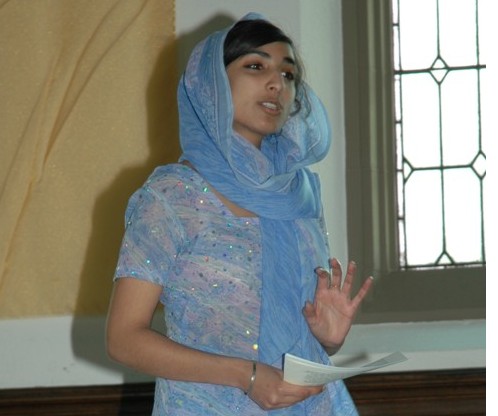 For my first post as a guest blogger, I wanted to address an issue that has been irritating me since September, when I first read about it. [An anonymous] Mehmaan wrote a post titled “Valarie Kaur, the peddler of self-promotion.” Mehmaan’s claim is essentially that Valarie Kaur is a big pakhandi.
For my first post as a guest blogger, I wanted to address an issue that has been irritating me since September, when I first read about it. [An anonymous] Mehmaan wrote a post titled “Valarie Kaur, the peddler of self-promotion.” Mehmaan’s claim is essentially that Valarie Kaur is a big pakhandi.
Mehmaan’s singular criterion for reaching the conclusion that Valarie Kaur is not just a pakhandi, but a big pakhandi, is that she is using social media and her website to promote herself as a speaker and to sell her documentary, “Divided We Fall,” inaccurately called a “movie” in the post.
I have never met Valarie and don’t know her family, but do want to clarify Valarie Kaur’s achievement, relegated to the realm of frivolity with the express purpose of making money, by Mehmaan in order to prove a point.
On September 11, the mood against anyone brown, especially Sikhs, changed drastically, and it culminated with the murder of Balbir Singh Sodhi on September 15. At that time, there was no Twitter. There was no Facebook. Even text messaging wasn’t normal everyday behavior. So there was no immediacy with information. I remember receiving emails through newsgroups I happened to be a part of documenting the steadily rising violence and blatant racism towards brown people. And then switching on my television to see zero updates on the “backlash.” Instead, it was just the same devastating image of planes crashing into the Twin Towers, followed by a turbaned and bearded Bin Laden. So what Valarie Kaur did at 20-years-old is nothing short of phenomenal. Along with her cousin, she went to document the brown experience on a cross-country trip, armed with plenty of panache, zero technical skills and a video camera. The fact is that there is no other documentary, which I am aware of, that weaves such a powerful narrative, intermingling a compelling personal story, and creating the link between not only Sikhs, but anyone of color, including the Japanese-American survivors of camps in the United States.
Last weekend I attended the Sikh Lens Sikh Art and Film Festival in Hollywood. I have attended film festivals all over North America and strongly believe in their need and presence in our community. Many times, however, the events get overshadowed by the glitz and glamour – the red carpet, the photographers, the eccentric outfits… I was therefore grateful that my experience at the Sikh Arts and Film Festival was a fulfilling one – I left knowing that Sikh Arts and Films bring value to our community and need to be supported. In addition, I felt the organizers made a special effort to keep the event focused on the directors, artists, musicians, actors, authors and organizations who were present. They recognized the fact that we are all in this together. Sikh Arts and Films are only beginning to be acknowledged, there is so much potential and growth that will still occur. However, this isn’t going to magically happen overnight, and it most definitely won’t happen without the community’s support.
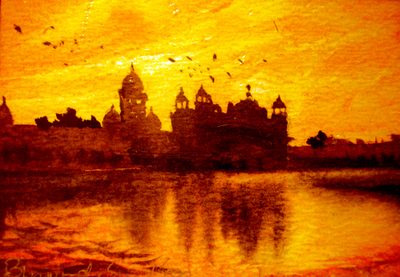 I was recently told that Sikhs in the UK spend 7 times more on license plates than they do on books (yes, 7 times!). While I’m not sure of the statistic in the US, the point is clear – perhaps we’re not investing in the right places? I think as a community we have begun to establish the need to support non-profit organizations that are working to address human rights, legal, education and activism issues (although we still have a long way to go to enhance our support). However, what goes hand in hand with this is the support and advancement of Sikh Art and Media. Without a doubt, events such as Sikh Lens are helping to pave the path – however, we as a community need to ask ourselves why we are so hesitant to spend money on independent films, children’s books, on historical references and on paintings. When I think about other immigrant communities, I notice that their advancement as a community comes from their support of one another. Whether we like to admit it or not, our community is extremely frugal and competitive with each other, and unless we start to move away from those stereotypes – we will not be creating a better world for our children.
I was recently told that Sikhs in the UK spend 7 times more on license plates than they do on books (yes, 7 times!). While I’m not sure of the statistic in the US, the point is clear – perhaps we’re not investing in the right places? I think as a community we have begun to establish the need to support non-profit organizations that are working to address human rights, legal, education and activism issues (although we still have a long way to go to enhance our support). However, what goes hand in hand with this is the support and advancement of Sikh Art and Media. Without a doubt, events such as Sikh Lens are helping to pave the path – however, we as a community need to ask ourselves why we are so hesitant to spend money on independent films, children’s books, on historical references and on paintings. When I think about other immigrant communities, I notice that their advancement as a community comes from their support of one another. Whether we like to admit it or not, our community is extremely frugal and competitive with each other, and unless we start to move away from those stereotypes – we will not be creating a better world for our children.
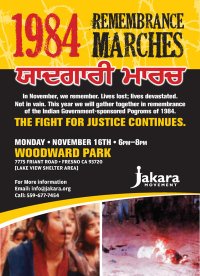 Through Sukhmani Sahibs, conferences, scholarships, film festivals, floats, and even ongoing camps, the Jakara Movement adds the next event to its on-going “Remember 1984″ campaign.
Through Sukhmani Sahibs, conferences, scholarships, film festivals, floats, and even ongoing camps, the Jakara Movement adds the next event to its on-going “Remember 1984″ campaign.
This November they begin their Remembrance Marches.
25 years ago there was a government-sponsored pogrom in Delhi and throughout many parts of India that left tens of thousands dead. Orchestrated by the Indian Government, the perpetrators of these pogroms roam free today. Join us and connect in solemn remembrance with Sikhs and non-Sikhs alike as we commemorate the events of 1984 and call for justice and bear witness to the genocide. We will not be silenced.[link]
The Event will consist of a series of silent marches in the various regions, followed by video screenings, speeches, and a candlelight vigil.
Attend one at a city near you:
- BAKERSFIELD – Silver Creek Park – Saturday, November 7th, 2009, 5-7pm
- BAY AREA – TBA
- FRESNO – Woodward Park – Monday, November 16th, 2009, 6-8pm
- RIVERSIDE – Glen Avon Heritage Park – Wednesday, November 18th, 2009, 6:30-8:30pm
For those in Bakersfield, this week (date to be updated) watch ABC affiliate KERO, Channel 23, to see members of the Jakara Movement talk about this weekend’s Remembrance March in Bakersfield.
For more information on the march visit the Jakara Movement blog, website, or Facebook page. See you there!
Sir Javai Te Javai, Mera Sikhi Sidak Na Javai
If I lose my head, so be it. But I must not lose my Sikhi.
After 16 months of tremendous effort and hundreds of thousands of dollars in spend, the Vismaad team brings us their fourth animated Sikh film, Bhai Taru Singh. We’ve blogged about the film before and about Bhai Taru Singh’s legacy. Now having had the privilege of watching the film last weekend, I’d like to share a few thoughts.
In years past, during the quickly cooling evening hours of dusk a Sikh child would huddle up next to their grandmother for the warm not only of her body and but also her captivating stories. Night after night, Beji would weave together real life tales of Sikh courage and bravery, instilling a sense of intrinsic pride, faith and determination that would provide a foundation of strength for young Sikhs in an unfriendly world.
But things have changed. Hectic schedules, disconnected families, ubiquitous technological distractions, and language issues have made these kind of life moments a rare occurrence. Whereas the Sikh panth has relied heavily on, and benefited from, its rich oral traditions, the current lack of intra-generational transference is a major concern. What are Sikhs without their history? Who else begins every supplication to the Creator by remembering and reflecting on their entire history? However, the Ardas we recite daily is only shorthand summary of our history, so what relevance does it hold, if you don’t actually know why we say charkrian de chare, aarye naal charai gaye, or sikhi kesan suasa naal nibhayi? So it is into this vacuum that a movie on Bhai Taru Singh attempts to fill a void.
Tragedies have a way of uniting people. As did 1984 for Sikhs. In the 25 years since, divisions have again formed in the panth. But a great new initiative in Toronto is asking people to put aside the differences that keep us apart and unite in remembering 1984. [Hat tip: Mapleleaf Sikh]

In many ways, the Punjabi-Sikh art scene is expanding exponentially these days. Just 10 years ago, beyond major, mainstream singers, I don’t think there was an arts scene, except maybe in people’s homes. Today, there are film festivals in most major cities like Spinning Wheel and the upcoming Sikh Heritage Film Fest in NY, art exhibits in museums such as the recent exhibit at NY’s Rubin Museum and current exhibit at the London’s Victoria and Albert, and even spoken word shows like When Lions Roar and Lahir. There are independent artists writing thoughtful lyrics, creating original beats, and giving some of our community’s concerns a voice. One of my favorites from this summer is Humble the Poet’s “Singh with Me” featuring Sikh Knowledge.
Yet, while the number and modes of art and artists grows in our community, many mainstream musicians are following  mainstream trends… videos featuring flashy cars rented for the shot, women as props, all at some party. Maybe they’re catering to what they think the audience wants, but the audience is clamoring for what they see as glamorous… which is manufactured to cater to the whims of the audience. This degenerative, downward spiral has led to recent hits such as RDB’s “Om Mangalam.” (See end of post.)
mainstream trends… videos featuring flashy cars rented for the shot, women as props, all at some party. Maybe they’re catering to what they think the audience wants, but the audience is clamoring for what they see as glamorous… which is manufactured to cater to the whims of the audience. This degenerative, downward spiral has led to recent hits such as RDB’s “Om Mangalam.” (See end of post.)
RDB is clearly identifiable as Punjabi-Sikh (let’s not talk about who’s a good or bad Sikh- that’s boring), wearing the now fashionable Palestinian support scarf, and singing Om Mangalam in this video on the homepage of their official site. This is definitely a case of trying to do too much and doing it all badly. There’s nothing inherently wrong with being Punjabi, singing Hindi music (while wearing a Palestinian support scarf), in a video with meaningless lyrics. It’s just not art. Some might call it entertainment, though I’d call it a train wreck.
Yes, I’m going to dare to talk about a film other than Slumdog Millionaire. This past weekend, I watched a film called Amal and I can’t stop thinking about it. While this movie has been shown at several independent film festivals, it hasn’t received the attention I think it deserves (actually, perhaps that’s a good thing – those films that get hyped are often dissapointing!). The story is quite simple,
AMAL, a multi-layered portrait of contemporary India, follows an auto-rickshaw driver in New Delhi (Amal) who is content with his small, but vital role in life. One day he drives an eccentric billionaire who, disguised as a vagabond, is searching the streets for the last morsel of humanity, and someone he can leave all his money to, and Amal’s life may change forever. AMAL serves up a visual feast for audiences. Filmed on location in New Delhi, India, this modern day fable asks the important question of what success means to each individual and ultimately reveals to audiences that the poorest of men are sometimes the richest.
It seemed pretty significant to watch this film during these pressing economic times. Amal, the lead role in the film, is played by Canadian actor Rupinder Nagra. A small role in the film is also played by Gurpreet Chana (The Tabla Guy). Gurpreet composed some of the music for the film too. If you manage to get your hands on this film, you won’t be dissapointed. In the meantime, here’s the trailer:

The Center for Asian American Media (CAAM) is a group working to present stories that convey the “richness and diversity of Asian American experiences” to the broadcast audience. They do this by funding, producing, distributing and exhibiting works in film, television and digital media. One example is this video directed for Mandeep Sethi, a bay area MC. As he says, Where do we go from here, I thought my people would be proud of their heritage and instead they want to bury it.
Also presented by the Center, is the upcoming 27th Asian American Film Festival in San Francisco. For those of you in the area, here are some of the films you might want to catch.
I spent the past weekend surrounded by Sikh Art and Film at the annual Spinning Wheel Film Festival in Hollywood. I usually attend these events with high expectations, hoping to be inspired and moved and there are always one or two films that provide that sustenance. The films were creative, such as The Making of Liverpool – an artistic animation inspired by a painting by The Singh Twins which explores 800 years of Liverpool’s history. The films were educational, such as Cultural Safari – directed by Sandeep Singh and produced by the Kaur Foundation – describing the basics of Sikhi for children of all ages [I have to say that this is one of the most impressive educational films I have come across]. The films were also daunting, such as Warrior Boyz – made by Baljit Sangra which touched upon the root causes of gang violence in the Punjabi community of Vancouver. A favorite of the crowd was Kuldip Powar’s Unravelling – a poetic inter-generational dialogue between the film director and his grandfather about the experience of war all posed in Urdu poetry.
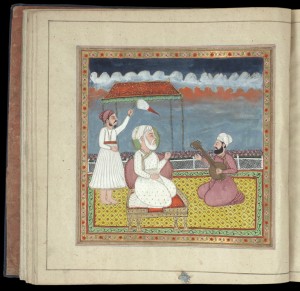 There were many other well-made films such as 35, Kabaddi Cops, and Right to Turban which rightfully deserve mention (and have been discussed or will be discussed in future posts), however what I appreciated most about the weekend was the final day of the festival – which was devoted to lectures on Sikh Art and History. Staff from the Anglo Sikh Heritage Trail and other UK-based organizations presented the attendees with a glimpse into the historical legacy of the Sikhs. One of the lectures was titled the Epic of Saragarhi and discussed the 21 soldiers of the Sikh regiment who defended a remote post against an estimated 10,000 hostile tribesmen. Michael O’Keefe from the British Library discussed Sikh artifacts and paintings and detailed an image of Maharani Jindan Kaur’s Gutka of the Sukhmani Sahib (see picture to the left). The day ended with a panel showcasing Sikhs in Theatre and Music, including traditional music and also hip-hop. Mandeep Sethi and Jagmeet Singh, rappers from LA, ended the festival with amazing performances showcasing their incredible talent of telling stories through hip-hop.
There were many other well-made films such as 35, Kabaddi Cops, and Right to Turban which rightfully deserve mention (and have been discussed or will be discussed in future posts), however what I appreciated most about the weekend was the final day of the festival – which was devoted to lectures on Sikh Art and History. Staff from the Anglo Sikh Heritage Trail and other UK-based organizations presented the attendees with a glimpse into the historical legacy of the Sikhs. One of the lectures was titled the Epic of Saragarhi and discussed the 21 soldiers of the Sikh regiment who defended a remote post against an estimated 10,000 hostile tribesmen. Michael O’Keefe from the British Library discussed Sikh artifacts and paintings and detailed an image of Maharani Jindan Kaur’s Gutka of the Sukhmani Sahib (see picture to the left). The day ended with a panel showcasing Sikhs in Theatre and Music, including traditional music and also hip-hop. Mandeep Sethi and Jagmeet Singh, rappers from LA, ended the festival with amazing performances showcasing their incredible talent of telling stories through hip-hop.
While the film festival brought together a plethora of Sikh art mediums – what it did seem to be missing was the representation of women and the voice of women in these films. The films were predominately made by men and the issues discussed were predominately issues affecting men. This brought several issues to mind – do young Sikh women not feel encouraged to enter the field of Film? Do the current male Sikh filmmakers not feel comfortable telling the story of Sikh women? It seems to be of vital importance that as we develop and promote Sikh films, we ensure that the stories we tell are representative of the entire Sikh panth and pay particular attention to the stories of Sikh women.
I will leave with this quote, mentioned by Harbinder Singh of the Anglo Sikh Heritage Trail, but also very pertinent to the theme of this weekend’s film festival.
Until lions tell their own history,
History will always glorify the hunters.
– African Proverb
Only every so often I come across a petition in my inbox which advocates for an issue that I feel strongly about. I find myself more than happy to take the few minutes required to click on the links and add my name to the “Undersigned.” 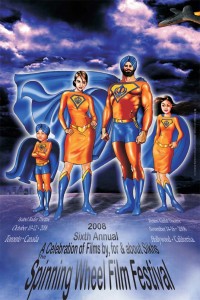 A few days ago, I was sent another such petition, but to be quite honest I didn’t quite know what to make of it.
A few days ago, I was sent another such petition, but to be quite honest I didn’t quite know what to make of it.
The petition, drafted in response to an advertisement for the upcoming Spinning Wheel Film Festivals, states that the “superhero” image being used depicts Sikhs in a negative manner. The author(s) suggest that the characters shown in the poster are portrayed in ways that go against the Sikh Rehat Maryada and Gursikh principles.
The current poster diminishes Sikh identity by playing fast and loose with Sikh Rehat Maryada in presenting the lead male and female characters as superheroes and role models. They appear more as villains, abandoning the true Sikh virtues. Going about “saving the world” with the hair uncovered is far from being obedient to Sikh Rehat and to the visible identification as a Gursikh. The Kirpan is supposed to be worn in a Gatra, not attached to a belt. Furthermore, pierced ears as in the case of the young girl are not in the spirit of how Sikhs should raise their children towards principled Sikh living.
I have my own opinions about the SWFF as it stands today, and although I was somewhat surprised by the choice of promotional material being used (from an aesthetic perspective) – I was much more intrigued about the nature and origin of the petition. I don’t know who authored the petition (does it matter?), but it brings up a much larger issue. The petition goes beyond a simple commentary of promotional material. The various comments left on the petition (even the incoherent ones) suggest that many individuals within our community still believe that Sikhs are only defined by certain external attributes:
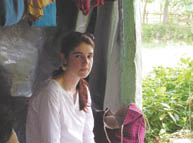 In an article published in the academic journal Ethnic and Racial Studies, last year, a PhD student in political science, Marie-Eve Reny makes a comparative study of political mobilization amongst the Sikhs of Punjab and the Uyghurs of Xinjiang in China.
In an article published in the academic journal Ethnic and Racial Studies, last year, a PhD student in political science, Marie-Eve Reny makes a comparative study of political mobilization amongst the Sikhs of Punjab and the Uyghurs of Xinjiang in China.
The Uyghurs are a Muslim community of Turkic descent in Western China. Many in the region have been fighting for their independence from China to establish Uyghurstan.
For her abstract, Marie-Eve Reny writes:
This article examines the reasons why the politicization of language has not been translated into disruptive forms of ethnic mobilization as opposed to the political salience of religion among the Uyghurs in Xinjiang throughout the 1990s and the Sikhs before and after the creation of Punjab in 1966. The article argues, from a structural-rationalist perspective, that language-based claims in Xinjiang and in Punjab have been accommodated by the respective central governments to a larger extent than religious claims have. Accommodation has taken the form of particular policies as well as greater incorporation of minority elites on the basis of language, which have in turn significantly reduced the possibilities of anti-regime sentiments and the incentives for disruptive forms of pressure on the basis of linguistic claims among the minority group. Religious claims have, however, not been accommodated in a similar way.
Sharon Stone’s recent comments about whether or not the earthquake in China was due to bad karma over Beijing’s occupation of Tibet has caused quite a stir. Stone is now facing a backlash in China with her films being boycotted (Um, what films?) and luxury retailer Christian Dior pulling advertisements featuring Sharon Stone from stores. The Chinese earthquake killed at least 68,000 people. China has been under much scrutiny in recent months over Beijing’s policies in Tibet. “I thought, is that karma – when you’re not nice that the bad things happen to you?” she mused at the Cannes Film Festival. However, many people feel that Stone’s contextual use of Karma is simplistic and in fact, inaccurate (the actress later apologized for her remarks).
Karma is an important concept for Buddhists, Hindus and Sikhs. Translated from the Sanskrit, it means simply “action”. Because karma is used in a number of ways and contexts this can be confusing…Stone’s take on karma is common – glossed over as an outcome that is the result of something done in the past – or even a past life. But the law of karma states that it’s the motive behind one’s actions that affects the outcome of that particular act. “The earthquake in China or the cyclone in Burma have much to do with environmental factors,” says Dhammadassin. “To invoke karma is more to do with our desire to nail things down and find someone to blame. But that’s not ours to do.” [Link]
So, it got me to thinking about what Sikhi says about Karma. Sikhs use the term generously (and sometimes, not so generously) but perhaps we don’t have a solid understanding of what it really means. The doctrine of karma, according to Sikh belief, is a part of the Divine law (hukam). “The whole universe,” says Guru Arjan, Nanak V, “is bound by action, good or bad” (GG, 51). Guru Nanak declares in the Japji that “all forms, beings, greatness and lowliness, pain and pleasure, bounties and wanderings are subject to the indescribable hukam and there is nothing outside the realm of hukam,” (GG, 1) and then adds that “karma determines the kapra, i.e. body or birth we receive and that it is through nadar (God’s grace) that one secures the threshold of moksa” (GG, 2). [Link]
Do you believe in Karma?
A few weeks ago, I wrote a post titled, “Metrosexual Murdabad!” Although I gained the ire of some commenters, I think amongst the Langar-ites, the ‘metrosexual’ trend is not the preference.
Waris Ahluwalia, of Inside Man fame and a sort of favorite in The Langar Hall — see here and here — made the following comments: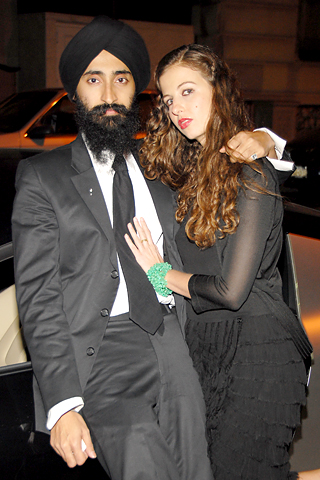
Waris Ahluwalia has been wearing makeup for about ten years, he told us last night at Chanel’s Tribeca Film Festival Party at the Greenwich Hotel. “I’m only telling you this because it’s New York Magazine, but I’m actually 68,” he quipped (he’s not, he’s in his thirties). We asked if his friends would be into man makeup, like Jean Paul Gaultier‘s new male cosmetics line, Monsieur. “No, no. I stopped hanging out with the theater group a long time ago,” he said. Oh, har! Ahluwalia also shuns the men-in-tight-pants trend. “I love trends,” he said. “Doesn’t mean I have to follow it.” Other trends Ahluwalia dislikes include the overusage of words like “bespoke” and “luxury.” “Everyone just calls things that. Bespoke olive oil?” he said. “I saw an ad in Wired for the new Acura. That ad was four lines, and they said ‘luxury’ fives times.” [link]
While bespeaking for Waris’ and our readers’ patience may be a luxury I can ill-afford as I write this sentence, still I am pleased that our turbaned Sikh Mr. Waris Ahluwalia seconds my thoughts on the ‘metrosexual’ trend. (Ok there really wasn’t a purpose for that last sentence other than I was looking to use ‘bespoke’ (or ‘bespeak’ in the present) and ‘luxury’ in the same line. Happy Monday!
We know the Britney Spears and Miley Rays of Hollywood tremendously influence the lives of our pre-teen and adolescent girls. The voices we keep hearing on television are those of white, multi-generational American, and suburban teens.

Their experiences are being boxed and represented as THE experience of adolescent girls in America. Rarely on television does the media interview pre-teen and teen girls of color from immigrant backgrounds living in urban/rural areas about their perceptions of life and the future – unless the story is on teen pathology from pregnancy to drugs and violence.
Therefore, I was pleased to see the trailer of a documentary, “Going on 13”, that is about pre-teen girls from minority, immigrant, and urban backgrounds discussing how they negotiate the whirlwind of changes and choices, from body image to relationships, just as girls in the suburbs.

The only distinction is how their social, economic, and cultural contexts add a different layer to the experience that is not a form of “mal-adaptation”, but another way of living. The film-makers’ goal was “… to show the reality of preteen girls and urban minorities, which isn’t often portrayed in the mainstream media” and “… wasn’t just focused on the pathology of urban youth”.
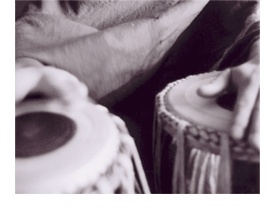 For those of you in the LA area planning on attending the Indian Film Festival of Los Angeles, be sure to check out some of the musical talent that will be highlighted throughout the week in conjunction with the festival. Gurpreet Chana, aka The Tabla Guy, will be performing…
For those of you in the LA area planning on attending the Indian Film Festival of Los Angeles, be sure to check out some of the musical talent that will be highlighted throughout the week in conjunction with the festival. Gurpreet Chana, aka The Tabla Guy, will be performing…
Tabla player Gurpreet has been taught in the Punjab Gharana (style) from his Ustad Ji Professor Parshotam Singh. He started by playing at the Gurdawara with kirtan and continues to do so. Gurpreet’s passion for percussion instruments has led him to experiment with other world beats and percussion instruments such as the djembe, congas, cajon, dhol, zarb and daf.
You can listen to some of his beats on his website and here’s a video of him performing during the Toronto Raptors halftime show:

I was a little hesitant to post about this, especially considering the numerous discussions we’ve had on this blog related to the negative image of Sikhs in the media. While a big fan of independent documentaries, I admittedly sighed when I came across an article about Air India 182, a film which was the opening feature at HotDocs, a film festival that was held in Toronto last weekend. My initial thought was that this was yet another way of perpetuating negative race relations in Canada.
While a big fan of independent documentaries, I admittedly sighed when I came across an article about Air India 182, a film which was the opening feature at HotDocs, a film festival that was held in Toronto last weekend. My initial thought was that this was yet another way of perpetuating negative race relations in Canada.
Air India 182, as it is simply titled, is a first-person account of the events leading up to the Air India tragedy and weaves together stories from those who are “directly involved,” including the families of those who died, investigators, and the “conspirators themselves.” Considering this, I didn’t expect to come across the director’s apt observations of how these events unfolded for the Punjabi community and what that meant for Sikhs in Canada,
Ultimately, Gunnarsson wanted to personalize the tragedy, to show the people involved, and give much more of a voice to the victims’ families, whom he believes didn’t get enough political recognition. “I felt at the time that people in Vancouver in the Punjabi community were being deprived of their rights as citizens of Canada. They did not have the same relationship to law enforcement or to political leadership as I did. It was being brokered through so-called community leaders, and the brokerage tended to happen at temples,” he says. [Link]


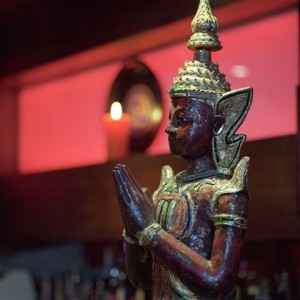 Karma is an important concept for Buddhists, Hindus and Sikhs. Translated from the Sanskrit, it means simply “action”. Because karma is used in a number of ways and contexts this can be confusing…Stone’s take on karma is common – glossed over as an outcome that is the result of something done in the past – or even a past life. But the law of karma states that it’s the motive behind one’s actions that affects the outcome of that particular act. “The earthquake in China or the cyclone in Burma have much to do with environmental factors,” says Dhammadassin. “To invoke karma is more to do with our desire to nail things down and find someone to blame. But that’s not ours to do.” [
Karma is an important concept for Buddhists, Hindus and Sikhs. Translated from the Sanskrit, it means simply “action”. Because karma is used in a number of ways and contexts this can be confusing…Stone’s take on karma is common – glossed over as an outcome that is the result of something done in the past – or even a past life. But the law of karma states that it’s the motive behind one’s actions that affects the outcome of that particular act. “The earthquake in China or the cyclone in Burma have much to do with environmental factors,” says Dhammadassin. “To invoke karma is more to do with our desire to nail things down and find someone to blame. But that’s not ours to do.” [